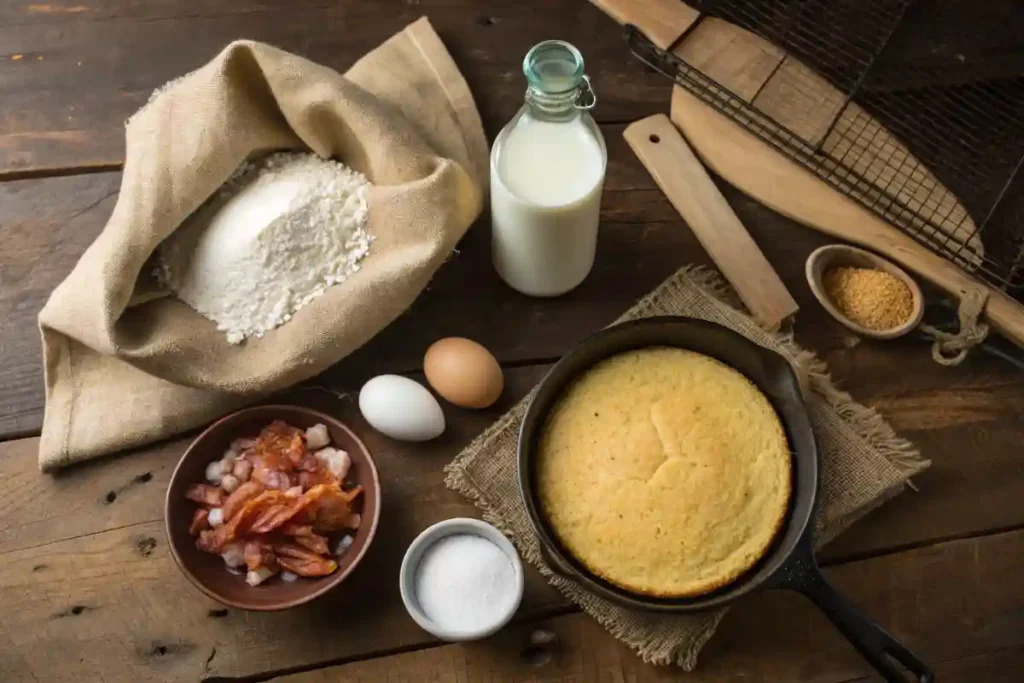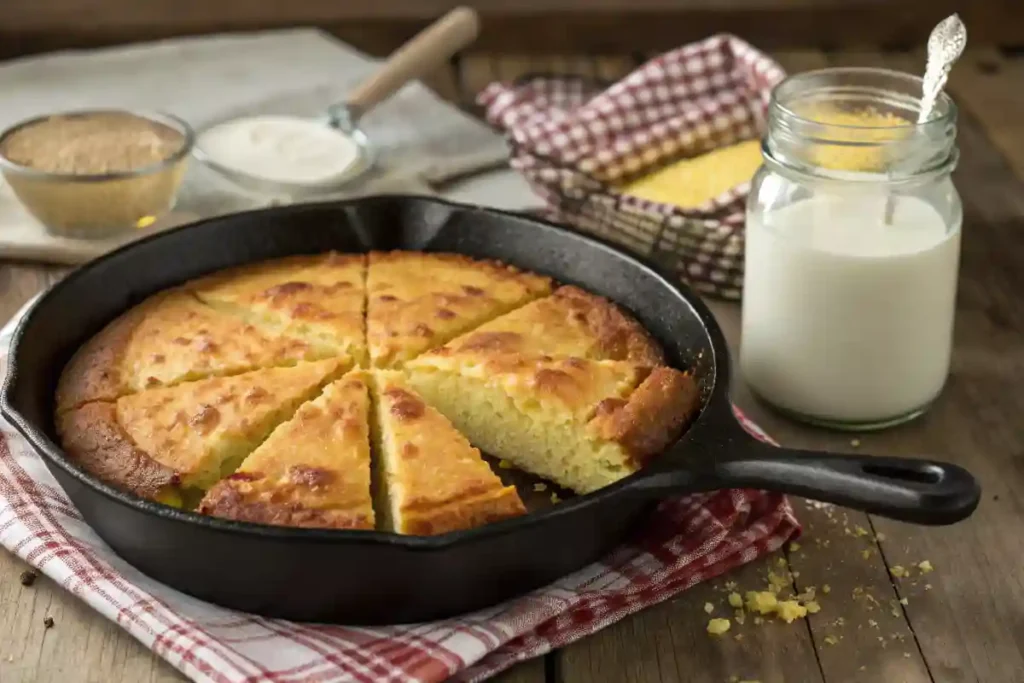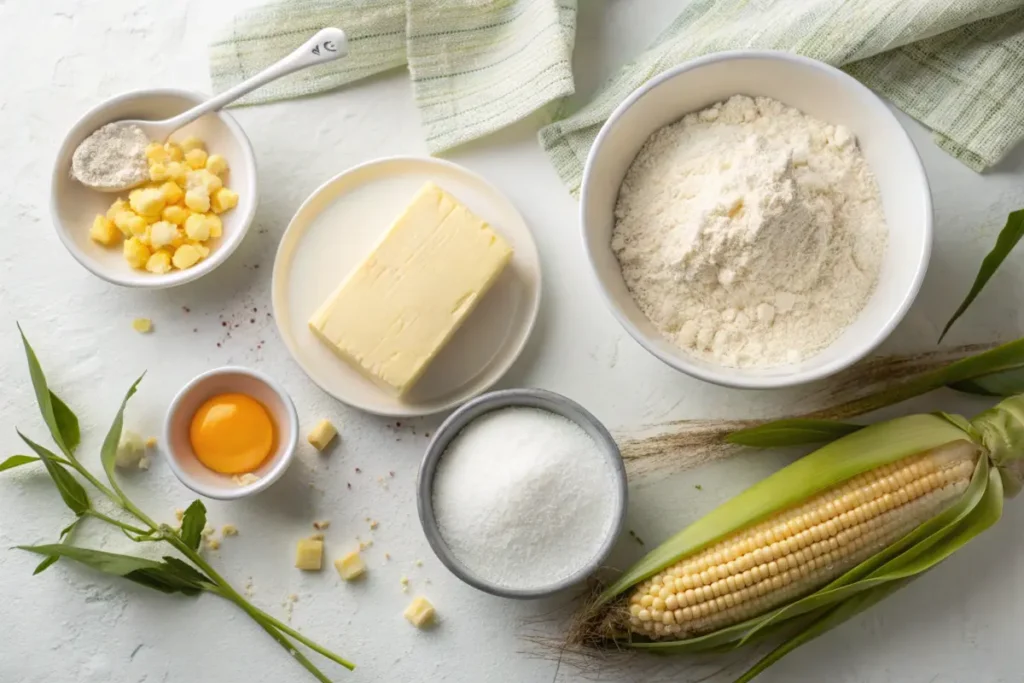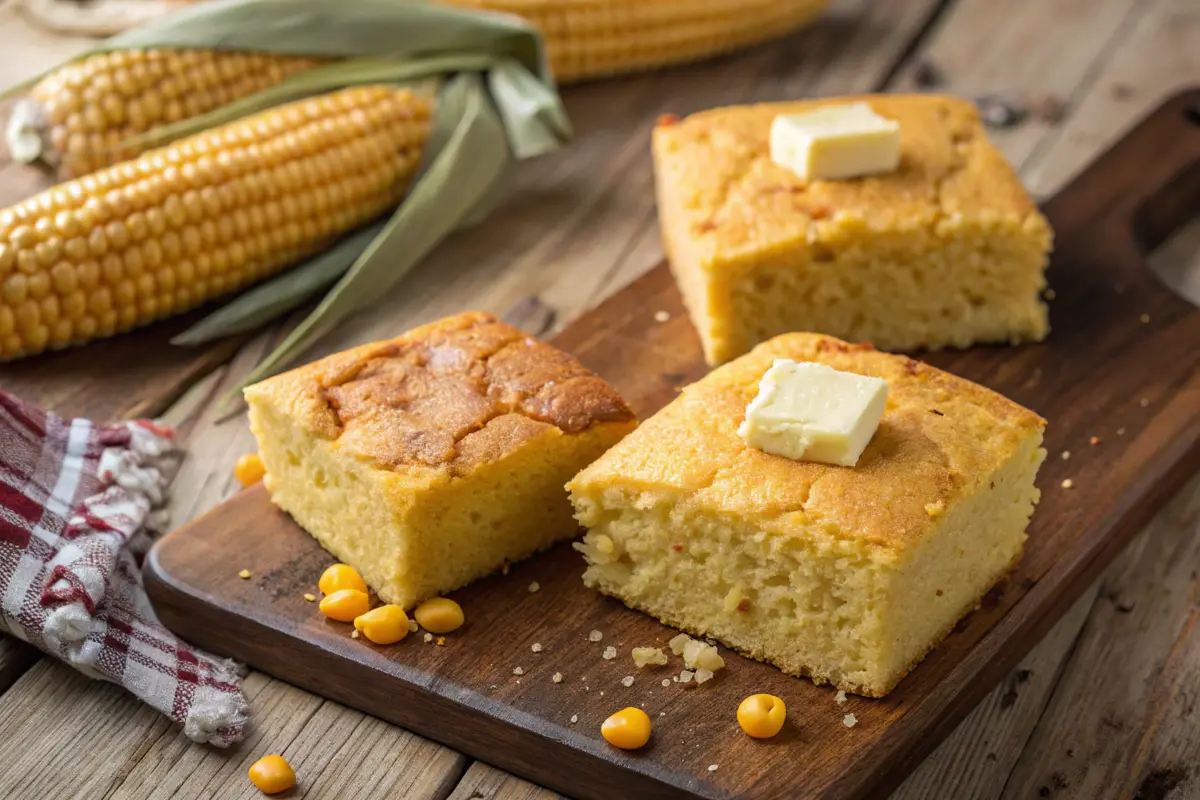Ever wondered about the humble cornbread? It seems simple enough, yet it holds a rich history and a surprising amount of variation. From family gatherings to everyday meals, cornbread is a staple in many cuisines. But, did you know that not all cornbread is created equal? In particular, the difference between cornbread and Southern cornbread sparks a lot of debate. This article will delve into the fascinating world of cornbread exploring their unique origins, ingredients, and tastes. We’ll uncover what makes Southern cornbread so special. So, whether you’re a seasoned baker or just curious about this classic side, let’s dig in!
Defining Cornbread: A Global Perspective
What is Cornbread?
At its heart, cornbread is a bread made primarily from cornmeal. Simple, right? Well, it’s more than just a quick mix. Cornbread has been a part of human diets for centuries. Indeed, it’s a staple food in many places. Think of it as a blank canvas for different tastes and cooking styles. You can find it sweet, savory, dense, or light. Cornbread is a chameleon of the baking world.
The Origins of Cornbread Worldwide
Early maize-based flatbreads
The story of cornbread starts with the domestication of maize. Therefore, before it became the loaf we know, early versions were more like flatbreads. Furthermore, indigenous people in the Americas have been baking with maize for thousands of years. They used simple techniques to create maize based dishes. These flatbreads weren’t exactly the cornbread that we see today. Nevertheless, they’re a key part of cornbread’s history.
Cornbread in other cuisines
As maize spread across the globe, so did the idea of cornbread. For example, in some African countries, you’ll find similar maize based flatbreads. In a different area, you might see a sweeter, cake-like cornbread. Indeed, different cultures have put their own spin on it. It shows just how versatile cornbread can be. Hence, it is clear that this bread’s story spans across many lands and traditions.
Basic Ingredients and Preparation
Common ingredients in most cornbread recipes
While recipes can vary, most cornbread starts with a few basic ingredients. Obviously, cornmeal is the main one. Then, you’ll usually find some form of liquid, often milk, water, or buttermilk. Next come leavening agents such as baking powder or soda. Also, fats like butter or oil help with the texture. Finally, you might see eggs and salt to hold it all together. Moreover, it’s these simple ingredients that form the base for countless variations.
Typical preparation methods
The preparation of cornbread is often quite straightforward. First, you combine the dry ingredients. Then, you add the wet ingredients and mix until combined. After that, the batter goes into the oven to bake. Some people like it in a skillet, while others prefer a baking dish. Indeed, the method can affect the final product’s texture and crust. Therefore, understanding these basics is key to understanding how different types of cornbread are made.
The Essence of Southern Cornbread
What is Southern Cornbread?
Now, let’s zoom in on Southern cornbread. It’s not just any cornbread; it’s a cultural icon. Indeed, Southern cornbread is a staple in the American South, deeply intertwined with the region’s history and traditions. It’s really more than a side dish; it’s a part of Southern identity itself. Therefore, understanding what Southern cornbread is requires a look at the specific ingredients and methods. These are the things that sets it apart.
Historical Roots of Southern Cornbread
Native American influences on Southern cornbread
The story of Southern cornbread begins with Native American cuisine. In fact, before European settlers arrived, indigenous peoples were already using maize to prepare a variety of dishes. Furthermore, early Southern settlers learned from them how to grow and use maize. This knowledge, therefore, paved the way for the rise of Southern cornbread. It’s a clear example of how cultural exchanges have helped to shape Southern cooking.
Cornmeal and Southern cooking traditions
Over time, cornmeal became a very important ingredient in Southern cooking. Moreover, it was affordable and adaptable. This made it a go-to for families from all walks of life. Consequently, cornbread became a common food, a comfort, and a symbol of Southern hospitality. More than just food, it represents the history and culinary heritage of the South.
Key Characteristics of Traditional Southern Cornbread

The role of white or yellow cornmeal
A key thing about Southern cornbread is the type of cornmeal used. Typically, white cornmeal is preferred for that classic Southern taste. However, yellow cornmeal is also an option. It depends on what you prefer or on regional variations. Indeed, the type of cornmeal has a big impact on both flavor and texture. Thus, choosing between white or yellow can change the final cornbread greatly.
The use of buttermilk in traditional recipes

Another vital ingredient that separates Southern cornbread is buttermilk. Buttermilk gives it a unique tang and also makes the cornbread very tender. It’s an essential part that helps to get the right moistness and taste. Furthermore, the acid in the buttermilk helps the baking soda work better. It is therefore a very important part of the process.
The absence of added sugar
Finally, traditional Southern cornbread is usually unsweetened. It doesn’t have any added sugar, unlike many other cornbread recipes. Instead, it is meant to be a savory side dish, pairing well with other foods. This, therefore, is an essential point in understanding the true nature of Southern cornbread. This savory quality is what makes it distinct.
For more about Southern Cornbread , visit our recipe article. From hearty sides to savory mains, there’s something for everyone.
Key Differences in Ingredients

Comparing Cornmeal Types
The impact of using white vs. yellow cornmeal
As we’ve touched on, the type of cornmeal is very important in cornbread. White cornmeal typically has a finer texture. It also lends a milder flavor, whereas yellow cornmeal can have a slightly coarser texture and a more pronounced corn flavor. So, while both are cornmeal, they give the cornbread different qualities. The choice truly depends on the desired outcome. You should select your ingredient accordingly.
The importance of milling and texture
Not all cornmeal is milled the same way. This also affects the final product. Coarsely ground cornmeal can give the cornbread more texture. On the other hand, finely ground cornmeal creates a smoother, more uniform crumb. Therefore, understanding the milling process is helpful to those who want to make cornbread. This knowledge will help you to get the exact results you want.
Sugar: To Sweeten or Not to Sweeten?
The role of added sugar in some cornbread recipes
While Southern cornbread typically skips the sugar, other cornbread recipes often include it. Added sugar can make the cornbread sweeter and more cake-like. It also helps with browning and gives it a different mouthfeel. The presence of sugar, therefore, shifts the purpose of the cornbread from a savory side to a sweeter treat.
Why Southern cornbread is traditionally unsweetened
The reason Southern cornbread is traditionally unsweetened is tied to its role in Southern meals. As a savory side, it is meant to complement, not compete with, the other dishes. The unsweetened aspect also makes it perfect for soaking up the juices of stews, greens, and other Southern staples. Therefore, its savory nature is an important part of why Southern cornbread is so unique.
Fats and Liquids: A Comparative Analysis
The use of butter, lard, or other fats
Different fats affect the texture of cornbread in different ways. Some recipes call for butter, which adds a rich flavor. Others may use lard, which gives a very tender crumb. Additionally, vegetable oil is also an option. It creates a moist cornbread. Each fat, therefore, brings something unique to the table. Understanding these differences is key to making great cornbread.
How different liquids affect the texture
The liquid used also plays a critical role. Buttermilk, as mentioned, gives Southern cornbread a tang and makes it tender. However, regular milk gives a milder flavor. Other liquids, like water, will result in a drier cornbread. Thus, the choice of liquid has a big impact. This is why it is important to understand the differences. Choosing the right liquid is key to achieving the desired texture.
Part 4: Texture and Structure: A Side-by-Side Comparison
Texture Differences Between Cornbread and Southern Cornbread
The texture is a key way to understand the difference between cornbread and Southern cornbread. In general, cornbread can vary quite a bit. It might be more cake-like, with a soft, tender crumb. Or it could be denser, with a coarser texture. However, Southern cornbread tends to have a distinct texture. It’s often described as more crumbly and slightly drier than some other types. This difference in texture is really important when discussing what is the difference between cornbread and southern cornbread? Indeed, the way the bread feels in your mouth is part of the eating experience.
The influence of ingredients on texture
The impact of fat content on crumb
The amount of fat in the recipe has a big impact on the texture. More fat often leads to a more tender and moist crumb. In contrast, less fat might result in a drier, more crumbly texture. Therefore, Southern cornbread, which often uses less fat than other versions, tends to have that characteristic crumbly texture. The fat content, therefore, is a primary element affecting the outcome.
How the mixing process affects the outcome
The way you mix the ingredients also matters a lot. Overmixing can develop the gluten in the flour. This, in turn, can lead to a tougher cornbread. In contrast, gently mixing the ingredients creates a lighter, more tender bread. The mixing method, thus, has a big influence on the final texture of the cornbread.
Evaluating the overall structure of Southern Cornbread
What makes it crumbly vs. cakey
Southern cornbread is designed to be crumbly, not cakey. The combination of less fat, buttermilk, and the lack of sugar all contribute to this texture. The absence of gluten development from minimal mixing also helps. These factors combine to give Southern cornbread its particular structure.
Understanding the effect of leavening agents
Leavening agents like baking powder or baking soda help the cornbread rise and become lighter. However, the right amount is essential. Too much leavening can lead to an uneven texture. On the other hand, too little might make the cornbread dense and heavy. Thus, balancing the leavening agents is crucial to achieving the right structure. It’s all about getting the right proportion for the best results.
Preparation Methods: From Mixing to Baking
Traditional Mixing Techniques
The importance of proper mixing for texture
As mentioned before, mixing is essential for the texture. For Southern cornbread, gentle mixing is the way to go. This technique keeps the cornbread from becoming too tough. It is also very important to not overmix. Therefore, a light touch is crucial.
How overmixing affects the final product
Overmixing is not recommended when preparing Southern cornbread. This leads to a denser and tougher texture. It does this by developing the gluten. Thus, a light hand is necessary for that classic crumbly Southern cornbread texture. Therefore, gentle mixing is a must for good results.
Baking Methods
The use of cast iron skillets for Southern cornbread
A cast iron skillet is a popular choice for baking Southern cornbread. It heats up evenly and gives the cornbread a beautiful, crispy crust. The skillet also helps retain heat. This is important for consistent baking. So, a cast iron skillet is a great tool for baking Southern cornbread.
Other baking methods and their impacts
While cast iron skillets are a favorite, other baking methods can also work. Regular baking pans are fine, but they may not give the cornbread the same crispy crust. Moreover, different materials may affect the baking time. Consequently, while a skillet is the classic choice, other options are available for baking.
Cooking time and temperature
Ensuring consistent cooking
Consistent baking is essential for great cornbread. The oven temperature should be consistent. Also, the baking time is often important. Using an oven thermometer can ensure accuracy. Furthermore, checking the cornbread with a toothpick can confirm that it’s fully cooked. Consequently, accurate time and temperature are important to achieve the best outcome.
The Taste Profile: What Sets Them Apart
Understanding the Flavor Profile of Cornbread
In general, the flavor profile of cornbread can vary quite a bit depending on the recipe. Some may be sweet, with a cake-like taste, while others are more savory. Moreover, the use of different fats and liquids also has a huge impact on the overall flavor. These variations, therefore, contribute to the wide range of cornbread experiences. Understanding these differences is essential to appreciate the versatility of this bread.
Exploring the impact of different ingredients
The ingredients really shape the taste. For instance, a cornbread made with a lot of sugar will obviously be sweeter than one with less. Likewise, using buttermilk or a different type of fat creates unique flavors that make it unlike any other. So, it’s the specific combination of ingredients that makes each cornbread unique. Therefore, each ingredient plays a crucial role in the final taste.
The Unique Taste of Southern Cornbread
The savory taste and its appeal
Southern cornbread has a distinct savory flavor that sets it apart. It’s not meant to be sweet like a cake, but rather a complement to other dishes. The cornmeal flavor is prominent, enhanced by the slight tang of buttermilk. This savory taste is perfect for soaking up the juices of stews and greens. Thus, this savory aspect is one of the hallmarks of Southern cornbread.
Pairing Cornbread and Southern Cornbread with Food
Complementing flavors for an optimal meal
The way you pair cornbread with other foods also plays a role in how it tastes. Sweet cornbread might be great with fruit or honey. However, Southern cornbread shines when served with savory dishes like barbecue, collard greens, or chili. Therefore, understanding how to pair cornbread can enhance the entire meal experience. Choosing the right pairings can really make a difference.
Regional Variations: Beyond the Basics
Regional Variations of Cornbread
Different flavors and textures in different areas
Cornbread isn’t just a single dish; it’s a family of recipes that vary by region. You can find sweet versions, savory versions, moist versions, and dry versions. Indeed, each area has its own way of making it, influenced by local ingredients and traditions. This regional diversity, therefore, shows how adaptable cornbread really is.
Exploring Different Styles of Southern Cornbread
Variations within Southern states
Even within the South, there are differences in how Southern cornbread is made. Some may prefer a finer cornmeal, while others prefer a more coarse texture. Also, the amount of buttermilk or fat can vary from recipe to recipe. These little differences really make each Southern cornbread unique. Thus, even within the region, a great amount of variation exists. This variety truly highlights the art of cornbread baking.
Influence of different cultures on cornbread
Cross-cultural adaptation of this staple
As cornbread spread, different cultures put their own spin on it. Some cultures might add spices, vegetables, or other grains. Therefore, this shows how cornbread has been adapted over time. These adaptations highlight the global impact of this simple bread. The history of cornbread is truly a story of cross-cultural influences. Understanding these cultural impacts is key to fully appreciating how cornbread has evolved. For many, it’s important to appreciate what is the difference between cornbread and southern cornbread?
Nutritional Value: A Comparative Overview
Nutritional Benefits of Cornbread
Cornbread, in general, can offer some nutritional benefits. Obviously, it provides carbohydrates, which give you energy. Furthermore, cornmeal is a source of fiber. It also contains some vitamins and minerals, such as B vitamins, iron, and magnesium. However, the specific nutritional content depends on the ingredients used. Therefore, it’s important to understand that not all cornbread is created equal, nutritionally speaking.
Key vitamins and minerals in cornmeal
As mentioned, cornmeal provides some important nutrients. These include B vitamins, which are essential for energy production. Also, iron is important for blood health. And magnesium is good for muscle and nerve function. So, cornmeal provides some valuable nutrients. However, the levels may vary depending on the type of cornmeal used. Therefore, it’s important to consider the overall nutritional profile.
Assessing the Nutritional Value of Southern Cornbread
How to make cornbread healthier
Southern cornbread can also be a part of a balanced diet. To make it healthier, you can use whole-grain cornmeal. This will increase the fiber content. Additionally, you can use healthier fats, such as olive oil or avocado oil. Furthermore, you can reduce the amount of salt or use low-fat buttermilk. Indeed, simple adjustments can make a big difference. These modifications can make cornbread better for your health.
Comparing the calorie count of both cornbreads
Understanding nutritional density
The calorie count of cornbread can vary. Sweet versions of cornbread, with added sugar and fats, will naturally have more calories than Southern cornbread. Therefore, Southern cornbread, being unsweetened, tends to have a lower calorie count. However, it’s important to consider the overall nutritional density of the food. This will help you understand the balance of calories and nutrients. Thus, looking at the nutritional composition is important, as well as the calorie count.
Modern Adaptations and Trends
Modern Adaptations of Cornbread
New ingredients, techniques, and flavors
Cornbread is not just stuck in the past; it’s constantly evolving. Modern cooks are experimenting with new ingredients, flavors, and techniques. For instance, some are adding herbs, spices, or even cheese. Others are using gluten-free cornmeal blends. Indeed, these new adaptations show how versatile cornbread can still be. These modern twists also add new life to this traditional dish.
The Evolution of Southern Cornbread
Updated versions that maintain the traditional essence
Even Southern cornbread is seeing some modern twists. Some chefs are using different types of cornmeal or adding new ingredients, while still keeping the traditional essence. For example, adding a touch of honey or maple syrup while maintaining the savory flavor profile. These modern takes on Southern cornbread honor the past, while also embracing new ideas. Thus, the classic recipe is being adapted to modern tastes. It is always interesting to note what is the difference between cornbread and southern cornbread when it is being innovated.
The Future of Cornbread and Southern Cornbread
How it stays relevant for the next generation
Cornbread, both traditional and Southern, continues to be a favorite among people of all ages. The future of this bread is in continuing to adapt, while also preserving its cultural heritage. This can be done by introducing new generations to this classic dish. It also includes embracing the different ways of enjoying it. Therefore, the future of cornbread looks bright, with more innovations to come.
Conclusion: Choosing the Right Cornbread
Summarizing the Key Differences
So, what is the difference between cornbread and southern cornbread? Well, as we’ve explored, it comes down to several key factors. Southern cornbread is typically made with white cornmeal, buttermilk, and no added sugar. It also often has a crumbly texture. On the other hand, cornbread can be more varied. It can be sweet or savory, cakey or dense, and use different types of cornmeal and liquids. These differences in ingredients and preparation truly make each type of cornbread unique.
Selecting Your Cornbread Based on Preference and Recipe
Ultimately, the “right” cornbread really depends on your personal preference and what you’re pairing it with. If you’re looking for a savory side dish to complement a hearty meal, Southern cornbread is a great choice. However, if you prefer a sweeter, more cake-like bread, then a different type of cornbread would be better. Consider the flavor profile you’re going for. Think also about the other dishes that you plan to serve with it. The best cornbread is the one that you enjoy the most.
Why both types of cornbread have their place in culinary traditions
Both cornbread and Southern cornbread have their place in culinary history and are important in different traditions. Cornbread is celebrated for its versatility and adaptability, while Southern cornbread is a cherished symbol of Southern heritage. Therefore, instead of seeing them as being in competition, we can appreciate them both for their unique qualities. Each type of cornbread has its own special story and place in the world of food.
Frequently Asked Questions
What is the main difference between cornbread and Southern cornbread?
The main difference lies in the ingredients and flavor profile. Southern cornbread is typically made with white cornmeal, buttermilk, and is unsweetened, resulting in a savory, crumbly bread. In contrast, cornbread can vary widely, often including sugar and using different liquids, leading to a sweeter and sometimes cake-like texture. Understanding these distinctions is key to appreciating what is the difference between cornbread and southern cornbread?
Can I use regular milk instead of buttermilk in Southern cornbread?
While you can use regular milk, it will change the texture and flavor. Buttermilk adds a tang and helps create a more tender crumb. If you use regular milk, the cornbread may not be as moist and will lack the characteristic tang. You can try adding a bit of lemon juice or vinegar to the milk to mimic the acidity of buttermilk. This will help to get closer to the intended flavor.
Is Southern cornbread healthier than other types of cornbread?
It’s not necessarily healthier in every aspect. Southern cornbread, being unsweetened, tends to have fewer calories and less sugar. However, the nutritional value depends on the overall ingredients used. You can make both Southern cornbread and other cornbreads healthier by using whole-grain cornmeal, healthy fats, and less salt. So, it’s about making informed choices about the recipe and ingredients.
Can I make Southern cornbread in a regular baking pan?
Yes, you can make Southern cornbread in a regular baking pan. However, it won’t have the same crispy crust as cornbread baked in a cast iron skillet. Cast iron skillets heat evenly and retain heat well. This makes them ideal for getting that crusty edge. If using a regular pan, you might need to adjust the baking time. Therefore, while a skillet is preferred, other options are available.
What is the best way to store leftover Southern cornbread?
The best way to store leftover Southern cornbread is in an airtight container at room temperature for a day or two. You can also store it in the refrigerator for up to a week. If you want to keep it longer, wrap it tightly and freeze it. When you’re ready to eat it, just thaw and reheat. Storing it properly will ensure it stays fresh.

